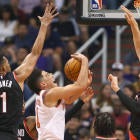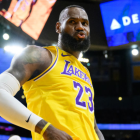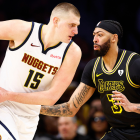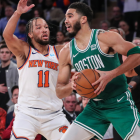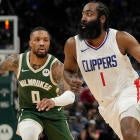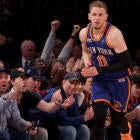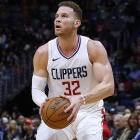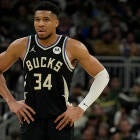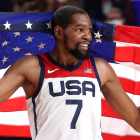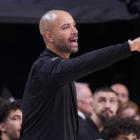Each week I put together an NBA Star Power Index, which is basically a heat map gauging who's generating the most buzz around the league. This, in effect, is the opposite -- a gauge of the players and trends that aren't getting enough attention.
 Rockets' (lack of) passing
Rockets' (lack of) passing
Passing has become all the rage in the NBA. Thirty assists and 300 passes per game are gold standards. Ball movement is king. Except, the Rockets again have one of the best offenses of all-time, and they hardly pass the ball at all. Entering Thursday, Houston was passing the ball less than 270 times per game, which is the second-lowest mark in the league. The only team making fewer passes per game? The Oklahoma City Thunder, who have the 21st-ranked offense entering Friday.
Now how can that be? How can the two most pass-averse teams in the league be such dramatically different offensive units? Well, on one level, it's pretty simple: Shooting. The Rockets have a ton of it, and OKC doesn't. A one- or two-pass possession that ends in a conversion looks -- and is -- entirely different than one that ends in a clang. That's why Houston was fifth in the league at 23.1 assists per game entering Thursday, while OKC was 24th -- because Houston makes hay with the few passes it makes, while OKC just makes, well, a few passes.
But shots don't just accidentally go in. Yes, Ryan Anderson, Eric Gordon and James Harden are all better deep shooters than anyone OKC can run out there, but shot selection is crucial. Whereas the Thunder -- on the rare possessions that they actually do move the ball side to side -- pass the ball more for effect, in more of a go-through-the-motions manner until they ultimately end up with some sort of isolation look anyway, the Rockets attack with their passes. They pass to score, if you will. Almost every pass is either moving toward the rim or kicking out to a shooter. No wasted action. Just look at the difference between a Rockets' one-pass possession vs. a Thunder one-pass possession:
Again, the Rockets have so much spacing that it doesn't take as many passes to find an open man. Paul uses the pull of Houston's myriad threats to hunt for shooters rather than just passing for the sake of doing so. He runs a pick and roll, draws the defense and keeps his dribble alive until a good shooter opens up for the high-percentage corner three. Boom.
Now, here's an OKC one-pass possession:
No movement. No anything. Just a basic entry pass, a face-up, and a contested mid-range jumper from Melo. That's not passing to score; that's passing the buck. That's why OKC is taking almost 30 shots a game from 15-24 feet, per NBA.com, the most in the league as of Thursday. They don't create action with the few passes they do make. They merely play my-turn, your-turn basketball. The pass that initiates it all is irrelevant. A formality. Here again, Paul George takes the requisite initial pass of a possession and turns it into a contested mid-range jumper off the dribble:
Obviously, not all low-pass possessions are created equal, and clearly ball movement is a good thing in most cases. The Warriors move the hell out of the ball. So do the Sixers. It's working out pretty well for them. And clearly what OKC is doing is not working out. But Houston tends to get the exact shot it wants in a few calculated, aggressive passes. It also helps that they have two of the best distributors on the planet. Just look at this James Harden dime:
That's another one-pass possession. You see what I'm saying? You drop dimes like that, who needs ball movement? For what, just so you can look at the stat sheet at the end of the game and see a big number of passes? The Rockets are just fine seeing a big number of points.
 A Blazing defense
A Blazing defense
When you think Blazers basketball, you think offense. You think Damian Lillard, C.J. McCollum, a fast pace and a lot of threes. In recent years, the Blazers and defense have not often collided in the same sentence. Until now.
As of Thursday (when they took a hit with a 103-91 home loss to the Bucks), Portland was giving up just 99.3 points per 100 possessions, which ranked second only to Boston. It's a pretty remarkable identity shift considering the Blazers didn't add any defensive stoppers to a roster that finished with the 21st-ranked defense a season ago.
One qualification to that is Jusuf Nurkic, who played just 20 games for Portland last season after being traded from Denver. He's made a huge difference at the rim.
146 players have faced >=40 FGAs at the rim. top 10 in total value saved relative to NBA average:
— Dan Favale (@danfavale) November 30, 2017
1. Kristaps Porzingis
2. Boogie Cousins
3. Jusuf Nurkic
4. Paul Millsap
5. Alex Len(!)
6. Joel Embiid
7. Kevin Durant
8. Hassan Whiteside
9. Anthony Davis
10. Jarell Martin(!)
When you watch the tape, the first thing that sticks out about Portland's defense is the collective discipline and energy -- which is pretty much everything defense is about. They're rotating. They're generally in the right spot. And they force the right kinds of shots. Before Thursday, Blazers opponents were taking 11.8 shots from 15-19 feet, which is the second-highest mid-range number in the league. Not coincidentally, teams were shooting just 43 percent against them entering Thursday, which was also tops in the league.
One way they're running teams off the 3-point line is by going over a lot of pick and rolls. Lillard and McCollum are both fighting hard over ball screens; their uptick in energy is apparent. What it's doing is forcing those 15-19 foot pull-ups more often as Nurkic becomes more and more of a feared rim protector. In the following clip, watch how hard McCollum fights over the screen not once, by twice, before Nurkic does his job:
Entering Thursday, teams were shooting a league-worst 58 percent at the rim against Portland, which is largely attributed to Nurkic, who blocked shots on three consecutive possessions during the Blazers' 31-11 run over the final eight minutes against the Wizards last Saturday. Portland erased a 10-point fourth-quarter deficit to win that game, and even with the loss Thursday, the Blazers sit at 13-9 with a top-six net rating.
 Splash Brothers' shooting gap
Splash Brothers' shooting gap
Klay Thompson is the perfect silent killer on a super team. He doesn't need attention. Hell, he hardly even needs the ball. Entering Friday, Thompson -- who's again cruising along unnoticed at over 20 points a night without interrupting a second of the Warriors' two-superstar flow -- is taking 12.2 shots with two seconds or less of touch time, which is tops in the league, and the 10.4 shots he takes via one dribble or less ranks second to Kristaps Porzingis' 11.1.
The guy either shoots it or moves it.
A modern coach's dream.
This is nothing new for Thompson, who, you might remember, scored 60 points last season while taking only 11 dribbles and touching the ball for a total of 90 seconds, which is still unfathomable. But this season, Thompson is doing it with even more precision that usual. Entering Friday, Thompson is shooting a career-high 46 percent from downtown, and his 77 made 3s are second only to James Harden.
Specifically, Thompson is killing teams in transition, where he's shooting over 57 percent (with a sky-high 75.6 eFG), and his 1.45 points per possession ranks first among all players with at least 50 possessions, via Synergy. That's a lot of fancy number talk that basically say he's drilling a ton of transition 3s like this:
Now, while Thompson is quietly enjoying the best shooting season of his career, his gunning mate Stephen Curry is arguably having his worst. Curry has been known to start off seasons slow, and you can pretty much bank on him being over 40 percent from deep. But as of Friday, Curry is hitting less than 37 percent of his 3s, and even that's a little bit deceiving.
Take Wednesday's victory over the Lakers. Curry finished 3 of 9 on 3-pointers, but he needed a pair in OT to even reach that mark. He was 1 of 7 in regulation, including a couple air-balls. Curry -- who still goes from a bad night to a great night faster than any player -- is having more games like this than you think.
He's still third in the league in 3-point makes with 70 entering Friday, but that's a product of sheer volume. Fact is, Curry hasn't shot better than 40 percent from deep in a single game since Nov. 6. Take out his three best games of the season (in which he propped up his stats with a collective 18-for-32 run), and Curry is shooting 33 percent from downtown.
What does this mean for the Warriors? Absolutely nothing. Curry represents the same threat to the defense at 36 percent as he does at 50 percent. He's terrifying either way, and the Warriors still have the top-rated offense in the league. This is really just about the thrill factor of watching Curry, which has diminished, at times considerably, since Kevin Durant came on board and the Warriors stopped needing him to be Superman.
Back when it was all on his shoulders to create the offense, Curry used to shoot himself out of these funks from game to game, if not quarter to quarter. But things have changed with Durant on board. Curry doesn't have to force anything anymore. If he's off, he's less likely to jack up 12 3s until his fortunes turn.
Another factor is the bar Curry set for himself. Most players would be thrilled to be shooting 37 percent from three and 46 percent from the field with the third-most made threes in the league. But that 402-three season really screwed up our perception of what's realistic for a shooter. Curry's not having a great shooting season by his standards, but it feels worse than it actually is.













